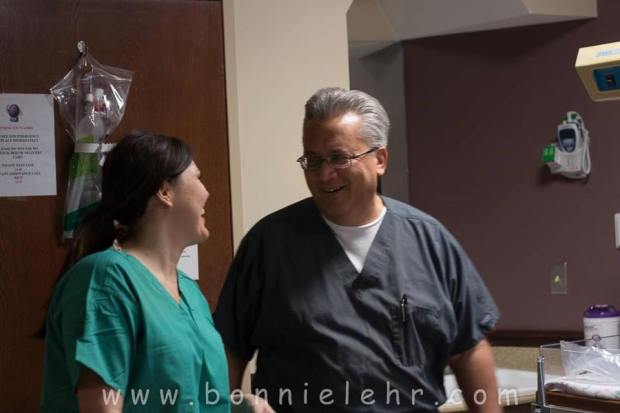Tarrant County Birth Network hosts meetings in Fort Worth every month with topics that entice doulas, birth professionals, providers, and consumers alike. This month the topic was Changing Hospital Birth: An Evidence Based Approach, and I was beyond excited to hear Carla Morrow, DNP, CNM and Steven Suba, MD speak on this topic!

The two (in addition to the rest of the CNM team) make up Grace Midwifery & OBGYN, and Carla Morrow has been on the forefront of advancing evidence based and family centered practices in our area for years now, starting with Texas Health Cleburne and now expanding to Texas Health Harris Southwest in Fort Worth.

Carla Morrow, DNP, CNM & Steven Suba, MD photo courtesy Bonnie Bee Photography
Side note: I’m also SO excited that Grace will be opening an office in Willow Park! I’ve had clients from and attended births in Weatherford (it’s my home town!), and it’s my goal to help meet opportunities that will make Parker County a better place to have a baby. Weatherford parents having the option to attend their prenatals close to home in Willow Park and then deliver in a birth center or hospital in Fort Worth will be amazing for Parker County parents!
Back to the meeting! I’ve had the honor of attending a client’s birth with Carla at the Fort Worth Birthing and Wellness Center, and she is an incredible midwife as well as visionary in advancing family centered maternity care. I loved hearing her perspective on how each of us can effect change.
Here are some highlights!
Carla started by sharing some of the statistics of Texas Health Cleburne both before and after her tenure there. Previously the hospital had a nursery separate from the labor & delivery unit and mostly scheduled inductions and cesareans. The Grace midwifery team took the unmedicated birth rate from 17% to 52%, and episiotomy rate from 16% to 4%.
If those number don’t convince you of the change that’s possible, I don’t know what will!
But why are things the way they are in some hospitals? If evidence shows that midwifery is associated with better outcomes, that episiotomy has very few benefits and shouldn’t be routine, or that newborn rooming in benefits baby and mom and should be encouraged, then why are these things not happening across the board?
Carla shared a “study about studies” that shows around 17 years pass between research being found and it’s practice implemented in healthcare settings. Plus, obstetrics is a field steeped in tradition. The American Society of Anesthesiologists now recommends freedom to eat and drink in labor so that women can keep their energy up, yet at many hospitals in the Dallas Fort Worth area moms will still be limited to only ice chips in labor. Why does the care environment not echo the evidence?

The traditions stick around, and it takes change agents to see challenges and meet them head on. So what does her model of change encourage?
- Midwifery model of care; low tech, high touch
- Promote physiological birth; labor starts and progresses on it’s own
- Collaborative care
- Respect the birth plan and birth team (they LOVE doulas!)
- Certified Nurse Midwives drive change at provider and administrative level, education for staff
- Family centered care
*(when appropriate & in the absence of health indications risk that rule out these options)

So how can we affect change? Carla mused that relationships are the key to driving change
- Necessary first step is to build trust by learning the environment, listening, and building relationships
- Identify issue; what could be better? How can we get there?
- Establish the team
- Implement change
- Monitor accountability
When she took questions, I asked how to handle the so called “hostile environment” where it seems tradition itself carries a defensiveness to change. Carla and the UNT midwife team in attendance talked on this and answered my question, how it is important to be a team player, and how we enact change by asking questions, listening and engaging with those able to push things forward, and how as consumers even just by spending our healthcare dollars with providers and at facilities that respect women and respect birth we send a message.
Carla wrapped up with talk about where we’re headed next- goals for water birth, hydrotherapy, and nitrous oxide to be more widely available, as well as in her own practices promoting early discharge, bedside resuscitation (when appropriate), and to do away with hatting! (The practice of wiping away vernix and putting a hat on babies, which studies show may hinder bonding and has no clear benefits)

photo courtesy FWBC Facebook
The Grace Midwifery & OBGYN team is an incredible care option I highly recommend to my clients, their website is linked here and they’re on Facebook too. I love working with them! Contact me if I can help!
I left the meeting feeling inspired and charged up to be a change agent in our community. How will you enact change? What do you think needs to change about hospital birth?

Sydney Williamson, certified Birth Boot Camp DOULA
– Childbirth Education – Birth Class – Cloth Diaper Class – Babywearing Instruction – Birth Doula – Postpartum Doula – Weatherford – Fort Worth – Arlington – Mansfield –
